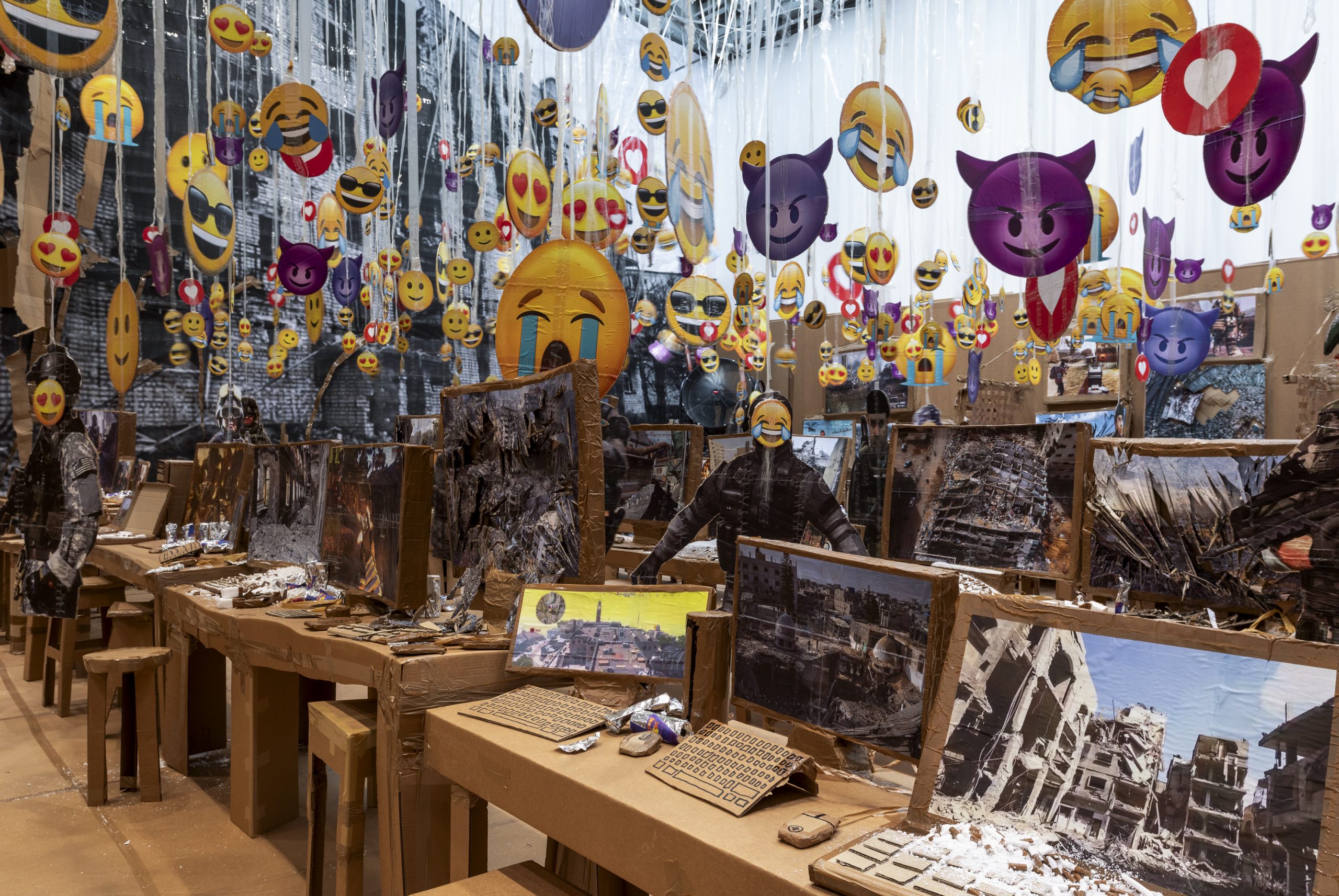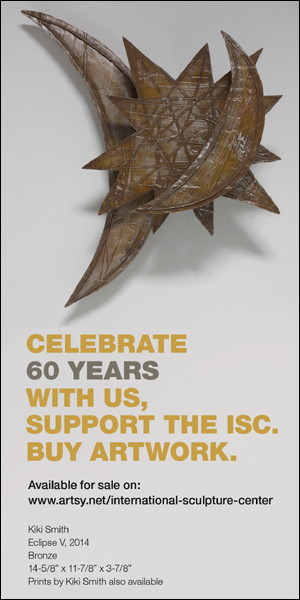New York
Clusters of colorful emojis hanging in midair beckoned from outside the gallery, intimating visual pleasure—though, as far as I’m concerned, they represent much of what is wrong with our present time. There was a strong possibility that I would walk away from the bustle around Gladstone’s smaller Chelsea space, but the opposite occurred because this was an installation by Thomas Hirschhorn. I’d previously confronted his indelible, alternately gory or playful, and deeply upsetting environments with mixed feelings. This time, however, I was almost exhilarated, and conquered—an apt description considering the subject at hand, namely the conduct and outcome of war.
Hirschhorn is a virtuoso who has developed a signature style of artistic production using signature materials and signature imagery. The materials that he deploys are cheap—cardboard, brown plastic packing tape, and printouts of photographs shot by photojournalists in war zones and gleaned from the Internet, with some Styrofoam and aluminum foil thrown into the construction mix. Here, the cardboard was cut, folded, assembled, and held in place with packing tape or brutally torn, giving shape to objects and life-size, two-dimensional, double-sided images of U.S. soldiers cropped at the bottom. Out of these base materials, Hirschhorn conjured a war room of sorts, with long, narrow cardboard tables and stools arranged in parallel rows across the width of the gallery.
The cardboard suggested—symbolically—that we’ve mastered the art of packaging and marketing our wars, and that the lives of others come cheap. On top of the make-believe tables stood cardboard computers with simulated keypads, their “screens” either showing frozen images of urban destruction or left dark—a reminder that everything is a construct, or can be made to seem so. Significantly, no one sat at those tables from which deadly orders might have been issued. Instead, viewers quietly ambled through a forsaken environment built up from scratch. Disaster had apparently struck here as well—one wall was collapsed, and many of the screens had seemingly imploded. War is always brought back home. Missiles and drones controlled from afar also effect great psychological damage at the sender’s end.
The ravaged buildings and infrastructure shown on the screens stood in for casualties. The hovering paper and cardboard cutouts of heavily armed American warriors in combat gear suggested the Second Gulf War, which was approved during a period of jingoistic fervor by an overly credulous—and somewhat intimidated—U.S. Congress, willing to gobble up false claims and alternate facts dispensed by certain authorities supposedly in the know and seeking to appease constituents wanting their pound of flesh. War is transactional, a business proposition from which some stand to profit at the expense of others, who are written up as mere collateral damage. After all, the show must go on.
In Hirschhorn’s war room, as in many other places, reality is perceived by way of still or moving images, and the written or spoken word; charging stations loaded with simulacra of tablets and smartphones stood along one side of this video-playroom, where it seemed some kind of frat party had gone wild. Fake crushed cans lay next to one fake keyboard, and fake cigarette ashes half-buried another—more rubble. I imagined verbal missiles flying back and forth—as in “Dude! Another one bites the dust” and “Bro! This one is so toast.” War can be such fun: so many minds zapped numb by an onslaught of extreme violence, stupidity, and grammar-less texts.
Hirschhorn’s fabricated, make-believe objects underscore the question of what constitutes reality at our moment in history, when facts and truth itself are under attack. The title of the installation was, after all, Fake it, Fake it—till you Fake it. It could be a Silicon Valley (i.e., arch-capitalist) mantra, as well as a statement evoking a more wide-ranging way of life in the age of virtual realities and artificial intelligence. Our empire teeters, as all empires eventually will, while growing numbers of people both in the U.S. and elsewhere shake off the illusory American Dream as if it were a bad hangover.
The conduct of war across great distances, Hirschhorn reminds us, reduces the opposite camp to an abstraction. Those on the other side are no longer people. Instead, they are data subject to manipulation, and, if need be, annihilation. This type of white-collar warfare—I can picture similarly arranged and purposed rooms on Wall Street—conducted from another country or continent, introduces a new chapter in the dehumanization of the opponent, of entire peoples and cultures: humans and their sentiments reduced to emojis, memes, and signs. The theater of war has become the theater of the absurd, to the nth degree. Hirschhorn has shown us where we stand.




